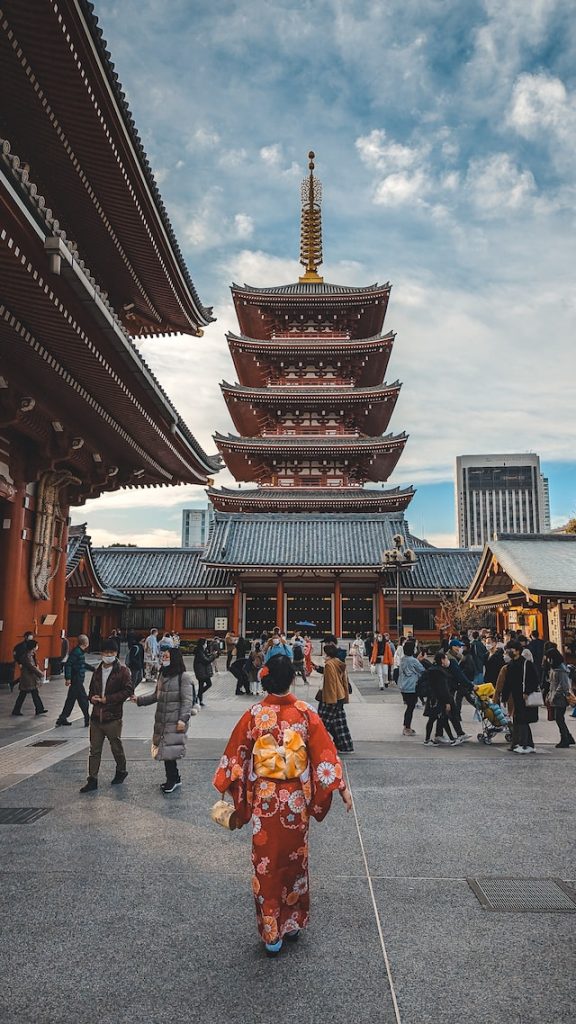The sound of drums echoes through the streets as crowds of people gather to celebrate Sanja Matsuri, one of Tokyo’s most vibrant and lively festivals. The event, which takes place every May just a month or two after the cherry blossom festivals, pays tribute to the three founders of the Sensoji Temple in Asakusa: Hinokuma Hamanari, Hinokuma Takenari and Hajino Nakatomo.
The festival is a dazzling display of traditional Japanese culture, with countless street food vendors, giant floats, and parades of costumed performers. The energy is palpable as revelers excitedly dance and shout in unison, their enthusiasm contagious.

As night falls, the atmosphere takes on an otherworldly quality as the illuminated floats traverse through the crowds. The air is thick with smoke from the food stalls and incense from the temple, creating a sensory experience that is both exhilarating and serene.
But Sanja Matsuri is more than just a celebration of Japan’s rich cultural heritage. It’s a symbol of community and unity, where people from all walks of life come together to honor their shared history. It is a reminder of the importance of tradition and the power of coming together to celebrate and honor our past, while looking to the future.
Historical Background of Sanja Matsuri
Centuries ago, during the Edo period, the Sensoji Temple in Asakusa stood as a symbol of both spiritual devotion and economic prosperity. The temple was believed to have been founded by three legendary brothers: Hinokuma Hamanari, Hinokuma Takenari, and Hajino Nakatomo, who lived during the 7th century. These men, renowned for their bravery and wisdom, were instrumental in spreading Buddhism throughout the region.
Over time, as the temple grew in prominence, an annual celebration began to take shape. The festival, known as Sanja Matsuri, emerged as a way to honor and express gratitude to the founders of the Sensoji Temple. The festivities initially commenced as a simple ceremony conducted by the temple’s monks and local residents. However, it soon evolved into a grand event that captivated the entire community.
Sanja Matsuri Through the Ages
Throughout its long history, Sanja Matsuri has weathered numerous challenges and obstacles. Despite facing periods of political turmoil, natural disasters, and even wartime restrictions, the spirit of the festival persevered. It became a symbol of resilience and an enduring testament to the Japanese spirit.
In the aftermath of World War II, Japan entered a period of rebuilding and recovery. Sanja Matsuri emerged as an important cultural event that not only upheld ancient traditions but also served as a platform for communal healing and unity. The festival’s revival in the post-war era brought together people from all walks of life in a shared celebration of resilience and optimism.
Present-Day Sanja Matsuri

Today, Sanja Matsuri has grown into one of Tokyo’s most highly anticipated and widely celebrated events. The festival continues to honor the founders of the Sensoji Temple while also showcasing the vibrancy of Japanese culture. Both locals and visitors from around the world flock to witness the awe-inspiring spectacle of towering festival floats, bustling markets, and captivating performances.
Through the centuries, Sanja Matsuri has remained a testament to the enduring power of tradition and the importance of community. It serves as a reminder that, despite the passage of time and the challenges encountered along the way, the spirit of celebration and cultural heritage will forever live on in the hearts and minds of those who partake in this remarkable festival.
Date and Duration of Sanja Matsuri
The annual Sanja Matsuri festival takes place over the span of three days, filling the streets of Asakusa with vibrant celebrations and cultural performances. Occurring on the third weekend of May, the festival is a highly anticipated event on the Tokyo calendar, drawing crowds from near and far.
Day 1: The Opening Ceremonies
The festivities kick off on Friday, with the vibrant opening ceremonies marking the beginning of the three-day extravaganza. Local dignitaries and religious leaders gather at the Sensoji Temple to offer prayers and blessings, setting a reverent tone for the days ahead.
Day 2: The Parade of the Mikoshi

Saturday is undoubtedly the highlight of Sanja Matsuri, as it features the grand procession of the mikoshi, ornate portable shrines that are eagerly carried through the streets. Embellished with elaborate decorations and vibrant colors, these mikoshi are believed to house the spirits of the three temple founders.
The parade is a sight to behold, with energetic participants donning traditional attire and moving in synchrony to the beat of drums and chants. The mikoshi, carried on the shoulders of dedicated individuals, weave through the bustling crowds, blessing the spectators with their divine presence.
Day 3: The Closing Celebrations
On Sunday, the festival draws to a close with a day of jubilant celebrations. The streets of Asakusa are transformed into a massive outdoor market, bustling with food stalls, game booths, and street performers. Visitors can sample a wide array of delicious Japanese cuisine, from savory takoyaki to sweet dorayaki, as they wander through the festive atmosphere.
The closing ceremonies culminate with a dazzling fireworks display, illuminating the night sky with bursts of color and enchantment. The crowd watches in awe as the fireworks dance above the Sensoji Temple, symbolizing the triumphant conclusion of Sanja Matsuri.
Religious and Spiritual Aspects
The Sanja Matsuri festival holds deep religious and spiritual significance for the people of Tokyo and visitors alike. Rooted in the history of the Sensoji Temple and the founders it venerates, the festival is an opportunity for participants to connect with their spiritual beliefs and seek blessings from the ancient deities.
Sensoji Temple: The Heart of Sanja Matsuri
At the heart of the festival stands the Sensoji Temple, a sacred sanctuary that attracts millions of visitors each year. Believed to have been established in the 7th century, the temple is dedicated to Kannon, the Buddhist goddess of mercy. During the Sanja Matsuri, the temple becomes a focal point for religious ceremonies, prayers, and rituals.
Purification Rites: Cleansing the Soul
Before entering the Sensoji Temple, participants engage in a purification ritual known as temizu. Attendees cleanse their hands and mouths with water from a communal fountain to purify their bodies and souls. This act symbolizes the removal of impurities and prepares individuals for a deeper connection with the divine.

Procession of the Mikoshi: Carrying the Divine
One of the most captivating spiritual aspects of Sanja Matsuri is the procession of the mikoshi, the portable shrines that play a central role in the festival. These elaborately adorned structures are believed to contain the spirits of the three temple founders. Dedicated participants, known as mikoshi carriers, bear the weight of the shrines on their shoulders, offering reverence and guidance to the deities as they navigate through the crowded streets.
The Role of Shintoism: Harmonizing Ancient Beliefs
While the Sensoji Temple is predominantly Buddhist, Sanja Matsuri also incorporates elements of Shintoism, Japan’s indigenous religion. Shinto beliefs exalt the divine spirits, or kami, that reside in nature and ancestral spirits. The festival’s union of both Buddhist and Shinto practices illustrates the harmonious coexistence of these religious traditions in Japanese culture.
Devotional Offerings: Seeking Blessings
During Sanja Matsuri, festival-goers have the opportunity to make devotional offerings at the Sensoji Temple. They can purchase omamori, amulets containing prayers for various aspects of life such as good health, success, and protection. Visitors may also light incense sticks and offer their prayers at the temple’s main hall, seeking blessings and guidance from the revered deities.
As the festival fills the streets of Asakusa with vibrant energy, participants also have moments for quiet reflection and introspection. Away from the bustling crowds, they can find solace in the serene corners of the Sensoji Temple, taking in the peaceful ambiance and connecting with their inner selves amidst the spiritual aura.
A Tradition Worth Experiencing
Sanja Matsuri is not just a festival; it is a testament to the rich history and cultural legacy of Tokyo. It is an invitation to step back in time, immersing oneself in the traditions and customs that have shaped the city for centuries.
Whether you are a history enthusiast, a lover of vibrant celebrations, or simply seeking an unforgettable experience, Sanja Matsuri promises to be an event that will leave an indelible mark on your heart. So mark your calendars for the next Sanja Matsuri, and prepare to be swept away by the enchantment and spirit of this remarkable festival.

